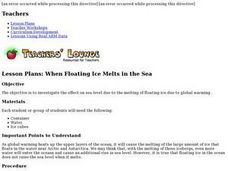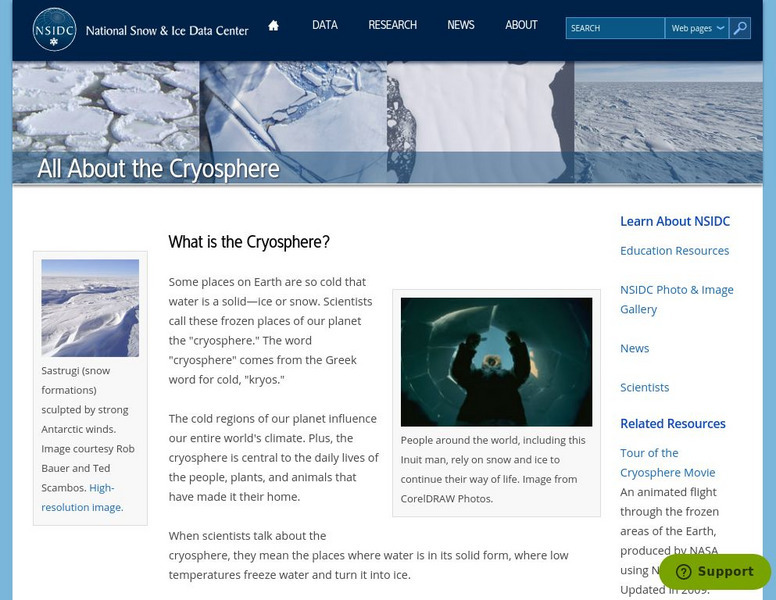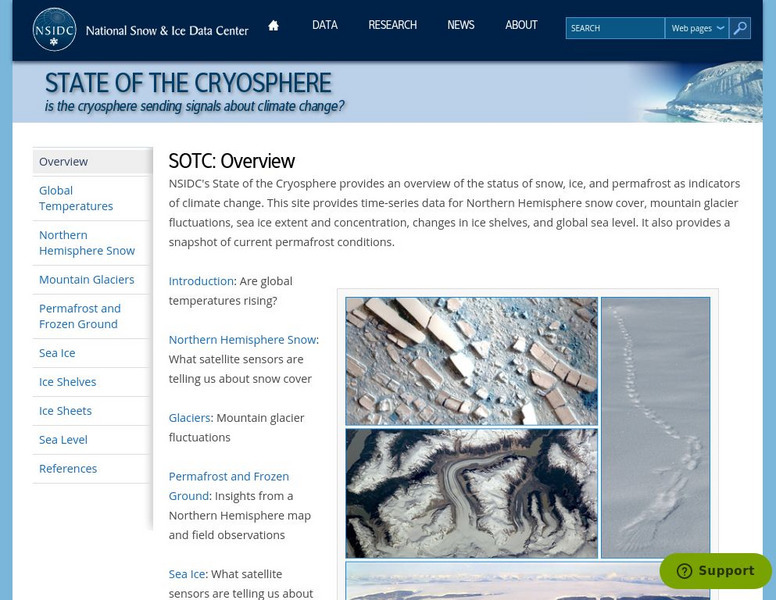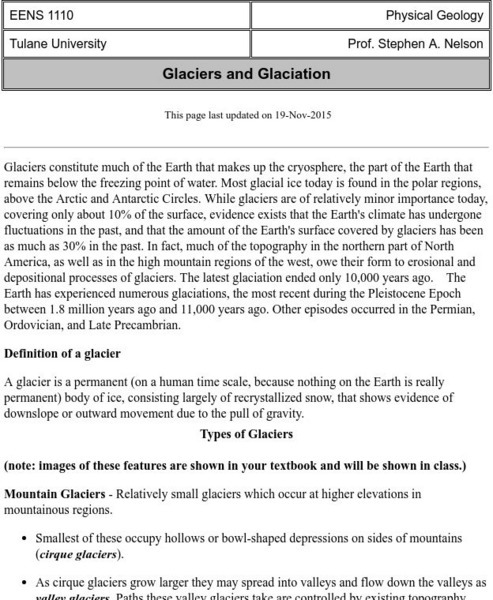Curated OER
Mars
After reading a short excerpt about the planet named after the Roman god of war, Mars, your class will answer four comprehension questions. The activity challenges them to fold over the paper and answer the questions without referring...
Curated OER
When Floating Ice Melts in the Sea
With this simple inquiry exercise young scientists observe the effects of melting ice on water level. Set up an easy experiment with floating ice cubes in a dish of water then have your pupils make and record their observations of the...
Curated OER
Ice Breakers
Young scholars understand the effects of global warming on icecaps. They investigate the worldwide consequences that may result.
Curated OER
Build an Ice Cap
Students research Earth science by conducting an experiment in class. In this ice-cap lesson, students identify what an ice cap is and create a biome using a box which measures 1 ft. x 1 ft. Students participate in an animal role-playing...
Curated OER
Ocean Water
Given data about the composition of ocean water, students complete 5 different questions using a provded table that relate to the ocean water (with elements Chloride, Sodium, Sulfate, and Magnesium). Some questions require calculation,...
Curated OER
Energy Resources
In this energy resources instructional activity, students read about the greenhouse effect and global warming. Then they explain why scientists are so concerned with greenhouse gases. Students also describe how global warming affects...
Curated OER
Ice Breakers: A Lab Experience About the Effects of Global Warming on Icecaps
Students describe the physical properties of ice and speculates on the dangers that icecaps might pose on a global scale. They then demonstrate, through a series of experiments, several physical properties of ice (ability to fracture,...
NASA
Nasa Earth Observatory: Polar Ice Fact Sheet
Learn about polar ice, its effects on energy exchanges, how much surface area it covers, and how it is affected by global warming.
The Wild Classroom
The Wild Classroom: Biomes of the World: Polar Ice Caps Biome
Learn about the polar ice cap ecosystem. Find out about plants, animals, adaptations, and conservation efforts.
Science Education Resource Center at Carleton College
Serc: Lab 1: Getting to Know the Cryosphere
A lab experiment (in a series of experiments) that explores the cryosphere. In this lab, students will be introduced to the different parts of the cryosphere and their locations. They will also be shown the connections between the...
PBS
Nova: Krakauer in Antarctica
Jon Krakauer describes what it's like to be in Antarctica and climb its highest mountain.
US Geological Survey
U.s. Geological Survey: Water Science for Schools
A collection of resources--pictures, maps, data, glossary--about water and the water cycle.
Science Education Resource Center at Carleton College
Serc: Sea Ice Extension for the Earth as a System Learning Activity
The purpose of this lesson is for students to learn how the Earth's systems interact on a global level. They will examine global environmental data and compare this to data on the polar regions. In the process, they will develop an...
National Snow and Ice Data Center
National Snow and Ice Data Center: All About the Cryosphere
What makes up the polar ice caps (cryosphere) and why are they important to those who don't live there? This comprehensive resource answers these questions and provides dramatic evidence for global warming.
National Snow and Ice Data Center
National Snow and Ice Data Center: State of the Cryosphere
This site provides thorough information about the status of snow and ice as indicators of climate change. This site has links to introductory information about the cryosphere, as well as info on specific area weather patterns.
Other
Tulane University: Physical Geology: Glaciers and Glaciation
Lots of information here about glaciation, types of glaciers, the formation of glacial ice, changes in glacier size, how glaciers move, glacial erosion, landforms produced by glaciers, glacial deposition and drift, effects of glaciation...
National Snow and Ice Data Center
National Snow and Ice Data Center: All About Glaciers: Glacier Types
Provides photographs of nine different types of glaciers with information about where they are located.
PBS
Pbs Learning Media: Glaciers
Featuring images of glacier formations, this interactive resource adapted from the National Park Service explains what glaciers are, where they are found, how they form, and how they move.
Other
Science
Get an overview of Antarctica. Find out what invertebrates, flowering plants, lichens, and mosses are living in this primitive ecosystem.
Curated OER
National Park Service: North Cascades: Glaciers / Glacial Features
The North Cascades has 316 glaciers. Learn how they were formed and how they affect the land.
CK-12 Foundation
Ck 12: Earth Science: Global Warming
[Free Registration/Login may be required to access all resource tools.] How global warming is affecting the Earth.
CK-12 Foundation
Ck 12: Earth Science: Global Warming
[Free Registration/Login may be required to access all resource tools.] How global warming is affecting the Earth.
National Snow and Ice Data Center
State of the Cryosphere: Ice Shelves
If you need an in-depth explanation of ice shelves, then this is a resource that's worth looking into. There are plenty of diagrams showing existing ice shelves and the way they are shrinking.
US Geological Survey
Us Geological Survey: Glaciers and Ice Caps: Storehouses of Fresh Water
Locate glaciers and ice caps on a world map at this USGS site. Read about the formation of galciers and other interesting facts. Learn about the effects glaciers have on the landscape, and of their importance for our fresh water supplies.
























